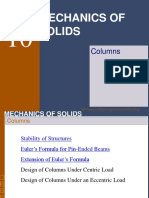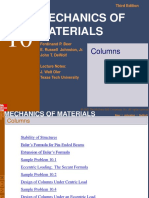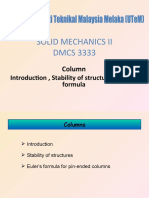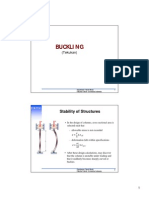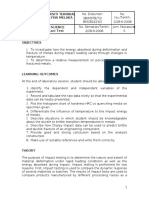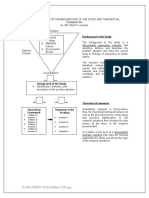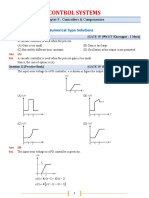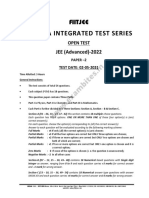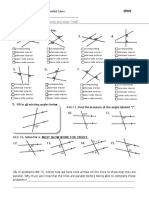Column Buckling & Stability Analysis
Uploaded by
M Kafeel KhanColumn Buckling & Stability Analysis
Uploaded by
M Kafeel KhanMechanics of Materials-II
Mechanics of Materials II
Columns
By
Dr. Riaz Muhammad
1 riaz@ceocs.edu.pk
CECOS University of IT and Emerging Sciences, KP, Pakistan
Stability of Structures
Mechanics of Materials-II
• In the design of columns, cross-sectional area is
selected such that
- allowable stress is not exceeded
P
all
A
- deformation falls within specifications
PL
spec
AE
• After these design calculations, may discover
that the column is unstable under loading and
that it suddenly becomes sharply curved or
buckles.
CECOS University of IT and Emerging Sciences, KP, Pakistan
10 - 3
Stability of Structures
Mechanics of Materials-II
• Consider model with two rods and torsional
spring. After a small perturbation,
K 2 restoring moment
L L
P sin P destabilizing moment
2 2
• Column is stable (tends to return to aligned
orientation) if
L
P K 2
2
4K
P Pcr
L
CECOS University of IT and Emerging Sciences, KP, Pakistan
10 - 4
Stability of Structures
Mechanics of Materials-II
• Assume that a load P is applied. After a
perturbation, the system settles to a new
equilibrium configuration at a finite
deflection angle.
L
P sin K 2
2
PL P
4 K Pcr sin
• Noting that sin < , the assumed
configuration is only possible if P > Pcr.
CECOS University of IT and Emerging Sciences, KP, Pakistan
Euler’s Formula for Pin-Ended Beams
Mechanics of Materials-II
• Consider an axially loaded beam.
After a small perturbation, the system
reaches an equilibrium configuration
such that
d2y M P
2
y
dx EI EI
d2y P
2
y0
dx EI
• Solution with assumed configuration
can only be obtained if
2 EI
P Pcr
L2
P
cr
2 E Ar 2
2E
A 2
L A L r 2
CECOS University of IT and Emerging Sciences, KP, Pakistan
10 - 6
Euler’s Formula for Pin-Ended Beams
Mechanics of Materials-II
• The value of stress corresponding to
the critical load,
2 EI
P Pcr
L2
P P
cr cr
A A
cr
2 E Ar 2
L2 A
2E
critical stress
L r
2
L
slenderness ratio
r
• Preceding analysis is limited to
centric loadings.
CECOS University of IT and Emerging Sciences, KP, Pakistan
10 - 7
Extension of Euler’s Formula
Mechanics of Materials-II
• A column with one fixed and one free
end, will behave as the upper-half of a
pin-connected column.
• The critical loading is calculated from
Euler’s formula,
2 EI
Pcr
L2e
2E
cr
Le r 2
Le 2 L equivalent length
CECOS University of IT and Emerging Sciences, KP, Pakistan
Extension of Euler’s Formula
Mechanics of Materials-II
CECOS University of IT and Emerging Sciences, KP, Pakistan
Sample Problem 10.1
Mechanics of Materials-II
An aluminum column of length L and
rectangular cross-section has a fixed end at B
and supports a centric load at A. Two smooth
and rounded fixed plates restrain end A from
moving in one of the vertical planes of
symmetry but allow it to move in the other
plane.
a) Determine the ratio a/b of the two sides of
the cross-section corresponding to the most
efficient design against buckling.
L = 20 in. b) Design the most efficient cross-section for
the column.
E = 10.1 x 106 psi
P = 5 kips
FS = 2.5
CECOS University of IT and Emerging Sciences, KP, Pakistan
Sample Problem 10.1
Mechanics of Materials-II
SOLUTION:
The most efficient design occurs when the
resistance to buckling is equal in both planes of
symmetry. This occurs when the slenderness
ratios are equal.
• Buckling in xy Plane:
1 ba3 2
2 I a a
rz 12
z rz
A ab 12 12
Le, z 0.7 L
• Most efficient design:
rz a 12 Le, y
Le, z
• Buckling in xz Plane: rz ry
1 3
2 I y 12 ab b2 b 0 .7 L 2L
ry ry
A ab 12 12 a 12 b / 12
Le, y 2L a 0 .7 a
0.35
ry b / 12 b 2 b
CECOS University of IT and Emerging Sciences, KP, Pakistan
Sample Problem 10.1
Mechanics of Materials-II
• Design:
Le 2L 220 in 138.6
ry b 12 b 12 b
Pcr FS P 2.55 kips 12.5 kips
Pcr 12500 lbs
cr
A 0.35b b
cr
2E
2 10.1 106 psi
Le r 2
138.6 b 2
L = 20 in.
12500 lbs 2 10.1 106 psi
0.35b b 138.6 b 2
E = 10.1 x 106 psi
P = 5 kips b 1.620 in.
a 0.35b 0.567 in.
FS = 2.5
a/b = 0.35
CECOS University of IT and Emerging Sciences, KP, Pakistan
Eccentric Loading; The Secant Formula
Mechanics of Materials-II
• Eccentric loading is equivalent to a centric
load and a couple.
• Bending occurs for any nonzero eccentricity.
Question of buckling becomes whether the
resulting deflection is excessive.
• The deflection become infinite when P = Pcr
d2y Py Pe
2
dx EI
P 2 EI
ymax e sec 1
Pcr
2 Pcr L2e
• Maximum stress
P ymax e c
max 1
A r2
P ec 1 P Le
1 sec
A r 2 2 EA r
CECOS University of IT and Emerging Sciences, KP, Pakistan
Eccentric Loading; The Secant Formula
Mechanics of Materials-II
P ec 1 P Le
max Y 1 2 sec
A r 2 EA r
CECOS University of IT and Emerging Sciences, KP, Pakistan
10 - 14
Sample Problem 10.2
Mechanics of Materials-II
The uniform column consists of an 8-ft section
of structural tubing having the cross-section
shown.
a) Using Euler’s formula and a factor of safety
of two, determine the allowable centric load
for the column and the corresponding
normal stress.
b) Assuming that the allowable load, found in
part a, is applied at a point 0.75 in. from the
E 29 106 psi. geometric axis of the column, determine the
horizontal deflection of the top of the
column and the maximum normal stress in
the column.
CECOS University of IT and Emerging Sciences, KP, Pakistan
Sample Problem 10.2
Mechanics of Materials-II
SOLUTION:
• Maximum allowable centric load:
- Effective length,
Le 28 ft 16 ft 192 in.
- Critical load,
Pcr
2 EI
2 29 106 psi 8.0 in 4
2
Le 192 in 2
62.1 kips
- Allowable load,
P 62.1 kips Pall 31.1 kips
Pall cr
FS 2
Pall 31.1 kips
8.79 ksi
A 3.54 in 2
CECOS University of IT and Emerging Sciences, KP, Pakistan
Sample Problem 10.2
Mechanics of Materials-II
• Eccentric load:
- End deflection,
P
ym e sec 1
2 Pcr
0.075 in sec 1
2 2
ym 0.939 in.
- Maximum normal stress,
P ec P
m 1 2 sec
A r 2 Pcr
31.1 kips 0.75 in 2 in
2
1 sec
3.54 in 1.50 in 2 2 2
m 22.0 ksi
CECOS University of IT and Emerging Sciences, KP, Pakistan
Design of Columns Under Centric Load
Mechanics of Materials-II
• Previous analyses assumed
stresses below the proportional
limit and initially straight,
homogeneous columns
• Experimental data demonstrate
- for large Le/r, cr follows
Euler’s formula and depends
upon E but not Y.
- for small Le/r, cr is
determined by the yield
strength Y and not E.
- for intermediate Le/r, cr
depends on both Y and E.
CECOS University of IT and Emerging Sciences, KP, Pakistan
Design of Columns Under Centric Load
Mechanics of Materials-II
• For Le/r > Cc
Structural Steel
2E cr
cr all
American Inst. of Steel Construction Le / r 2 FS
FS 1.92
• For Le/r > Cc
Le / r 2 cr
cr Y 1 2
all
2Cc FS
3
5 3 L / r 1 L / r
FS e e
3 8 Cc 8 Cc
• At Le/r = Cc
2 2 E
cr 1
2 Y
Cc2
Y
CECOS University of IT and Emerging Sciences, KP, Pakistan
Design of Columns Under Centric Load
Mechanics of Materials-II
• Alloy 6061-T6
Aluminum Le/r < 66:
Aluminum Association, Inc. all 20.2 0.126Le / r ksi
139 0.868Le / r MPa
Le/r > 66:
51000 ksi 351 103 MPa
all
Le / r 2
Le / r 2
• Alloy 2014-T6
Le/r < 55:
all 30.7 0.23Le / r ksi
212 1.585Le / r MPa
Le/r > 66:
54000 ksi 372 103 MPa
all
Le / r 2
Le / r 2
CECOS University of IT and Emerging Sciences, KP, Pakistan
Sample Problem 10.4
Mechanics of Materials-II
SOLUTION:
• With the diameter unknown, the
slenderness ration can not be evaluated.
Must make an assumption on which
slenderness ratio regime to utilize.
• Calculate required diameter for
assumed slenderness ratio regime.
• Evaluate slenderness ratio and verify
initial assumption. Repeat if necessary.
Using the aluminum alloy2014-T6,
determine the smallest diameter rod
which can be used to support the centric
load P = 60 kN if a) L = 750 mm,
b) L = 300 mm
CECOS University of IT and Emerging Sciences, KP, Pakistan
Sample Problem 10.4
Mechanics of Materials-II
• For L = 750 mm, assume L/r > 55
• Determine cylinder radius:
P 372 103 MPa
all
A L r 2
60 103 N 372 103 MPa
c 18.44 mm
c 2
0.750 m
2
c/2
• Check slenderness ratio assumption:
c cylinder radius
L L 750mm
r radius of gyration 81.3 55
r c / 2 18.44 mm
I c 4 4 c assumption was correct
A c 2 2
d 2c 36.9 mm
CECOS University of IT and Emerging Sciences, KP, Pakistan
Sample Problem 10.4
Mechanics of Materials-II
• For L = 300 mm, assume L/r < 55
• Determine cylinder radius:
P L
all 212 1.585 MPa
A r
60 103 N 0.3 m 6
212 1.585 10 Pa
c 2 c / 2
c 12.00 mm
• Check slenderness ratio assumption:
L L 300 mm
50 55
r c / 2 12.00 mm
assumption was correct
d 2c 24.0 mm
CECOS University of IT and Emerging Sciences, KP, Pakistan
Design of Columns Under an Eccentric Load
Mechanics of Materials-II
• An eccentric load P can be replaced by a
centric load P and a couple M = Pe.
• Normal stresses can be found from
superposing the stresses due to the centric
load and couple,
centric bending
P Mc
max
A I
• Allowable stress method:
P Mc
all
A I
• Interaction method:
P A Mc I
1
all centric all bending
CECOS University of IT and Emerging Sciences, KP, Pakistan
Flexural Buckling of Columns
Mechanics of Materials-II
• It is often the case that columns are restrained at the ends, and even within
the span.
• In the case of a column restrained from buckling about the minor axis, it is
possible that buckling may occur first about the major axis, and this
possibility should be considered.
• For columns which do not have pinned ends, buckling load is sometimes
expressed as a multiple of the Euler load.
• More often the buckling load is expressed directly in terms of the Euler load
and the column is considered to have an Effective Length “LE”.
• The Buckling load for a pinned ended column is expressed as;
PE = π2 EI / L2
PE = Overall column buckling load, often called Euler load after its originator
I = Second moment of area about the minor axis
CECOS University of IT and Emerging Sciences, KP, Pakistan
Extension of the Euler’s Formula
Mechanics of Materials-II
Buckling loads and effective lengths for some end conditions are shown
below.
CECOS University of IT and Emerging Sciences, KP, Pakistan
Extension of the Euler’s Formula
Mechanics of Materials-II
Buckling loads and effective lengths for some end conditions are shown
below.
CECOS University of IT and Emerging Sciences, KP, Pakistan
Methods used in Buckling Analysis
Mechanics of Materials-II
• There is a variety of methods available for the analysis of the buckling
problems. In this course we will briefly examine a few of these and
illustrate the application of these to column analysis.
1. Exact solution of governing differential equations
2. Energy methods
1. Raleigh Ritz method
2. Timoshenko’s method
3. Finite Difference method
4. Finite element method
CECOS University of IT and Emerging Sciences, KP, Pakistan
Exact Solution Method
Mechanics of Materials-II
This method is used for the problems for which governing
differential equations can be setup. The most satisfactory
solution is obtained if these equations can be solved exactly.
• For example; in the case of a column of uniform cross section
governing differential equation is;
Limitations
• Although a variety of column problems are analyzed using this method,
however, for perhaps majority of the cases, exact solution is not possible and
approximate solution of the buckling load must suffice.
• Sometimes the roots obtained are the lowest roots of the equation derived. In
reality there are infinite number of solutions to the buckling of which, in most
cases (but not all) the lowest buckling load is only one of the consequence.
• We do not know exactly the magnitude of the deflection, so these are
indeterminate in this type of solution.
CECOS University of IT and Emerging Sciences, KP, Pakistan
Energy Methods – Raleigh-Ritz Method
Mechanics of Materials-II
These methods are called as “Approximate” methods to over come
the problems/limitations faced in the exact solution method.
• Two methods are generally used and are described;
1. Raleigh-Ritz Method (RRM)
• This method use the “Principal of Minimum Potential energy”, which states
that for equilibrium, the potential energy of a system must be stationary with
respect to any variations in displacements.
• Potential energy consists of;
• strain energy stored in a body and
• the potential energy of any load applied to the body
• Strain energy of bending (stored) in buckled column is expressed as;
• Potential energy lost by the load is expressed as;
CECOS University of IT and Emerging Sciences, KP, Pakistan
Energy Methods – Raleigh-Ritz Method
Mechanics of Materials-II
Total Potential Energy change during buckling for an end loaded
column is expressed as;
Application of Raleigh-Ritz Method
In the application of Raleigh-Ritz method we assume;
1. Forms for the deflection of a column which satisfy the kinematics
boundary conditions
2. Determine the potential energy change at buckling in terms of the
‘coefficient of the deflection’.
3. Use principal of minimum potential energy to furnish solution
CECOS University of IT and Emerging Sciences, KP, Pakistan
Energy methods – Timoshenko’s Method
Mechanics of Materials-II
This is an alternative formulation of the energy expression to avoid
the use of double derivative by determining the strain energy of
bending from “Moment” expression.
• Moment can be evaluated for simple cases directly in terms of the applied
load and the assumed deflections.
• Total Potential Energy change at buckling can be written as;
Advantages/Disadvantages
• Greater accuracy for a given deflected form than the Raleigh-Ritz method, but
care must be taken in the determination of the bending energy and this arises
due to the avoidance of the use of second derivative.
• A further drawback lies in the fact that it does not have corresponding
applicability to plates or other structures and is purely set up for column
analysis.
CECOS University of IT and Emerging Sciences, KP, Pakistan
Energy Methods – Finite Difference Method
Mechanics of Materials-II
• To apply this approach to situations in which the moment at any point can not
be immediately derived on the basis of static equilibrium, Castigliano’s
theorem or the Unit Load method can be used in conjunction to evaluate the
moments.
Finite Difference Method
• This is more general approach to analysis of problems faced during exact
and approximate methods.
• These are numerical methods which requires no specification of any
deflected form.
• In this method the differential equation is approximated by a difference
equation.
Advantages
• It is very suitable for programming and has been widely used for buckling
analysis of plates and column systems.
• Higher order differential equation can be derived and these generally give
improved accuracy for a given number of sub divisions.
CECOS University of IT and Emerging Sciences, KP, Pakistan
Energy Methods – Finite Element Methods
Mechanics of Materials-II
• This is most widely used numerical method of analysis.
• In this method structure is sub divided into discrete elements and
analysis proceed on this basis.
• Higher order elements with more degree of freedom can be set up and
these can be used to deal with continuously variable cross sections
and loads.
CECOS University of IT and Emerging Sciences, KP, Pakistan
Euler’s Formula for Pin-Ended Beams
d2y
Mechanics of Materials-II
M P
y.........( M Py)
dx 2 EI EI
d2y
EI 2 M 0
dx
d2y P
y0
dx 2 EI
d2y P
k 2
y 0 ........( k 2
)
dx 2 EI
Solving
y A cos( kx) B sin( kx)
At , x 0
A0
At , x L
B sin( kL) 0
sin( kL) 0, for, kL
kL n ..........(sin 0.....so... sin( n ) 0)
n
• Consider an axially loaded beam. k
L
After a small perturbation, the system P n 2 2
2
reaches an equilibrium configuration EI L
such that n 2 2 EI
P
L2 KP, Pakistan
CECOS University of IT and Emerging Sciences,
Euler’s Formula for Pin-Ended Beams
Mechanics of Materials-II
Buckling first occurs for n=1 (kL=π).
For this critical load is given as
Pc n 2 2
2
EI L
2 EI
Pc 2
L
L
if .... y ymax ..at...x ...then...B ymax
2
y ymax sin( ky)
nx
y an sin .....(an ymax ) This is the equation for the curve deflection
L
Differentiating and solving we get the same Euler's Buckling formula
2 EI
Pc
L2
CECOS University of IT and Emerging Sciences, KP, Pakistan
Euler’s Formula for Pin-Ended Beams – Example -1
Mechanics of Materials-II
Determine the buckling load for thePin-ended column shown
using function;
n x
y a sin
l
Solution:
y a cos n n
d x
dx l l
2 2
y a sin n n
d x 2
dx
2
l
l
2
M P y P a sin n
x
l
2 2
y P y 0 E I a sin n n P a sin n 0
d x 2 x
E I
dx
2
l
l
2 l
d
2 2
2
E I d x2 y P y 0 solve P E I n 2
l
CECOS University of IT and Emerging Sciences, KP, Pakistan
Euler’s Formula for Pin-Ended Beams – Example -2
Determine the buckling load for thePin-ended column shown using function;
Mechanics of Materials-II
1
M x
x 0 y A sin ( n x) B cos ( n x)
P l
Solution:
d M M
y A cos ( 0) n B sin ( 0) n solve A
dx P l P l n
2
M P y P B
d M
y 0
dx
2
P
2
0 P B
d M
E I y P y 0
dx
2
P
d
2 M
E I y P y 0 solve P
d x2
B
x 0 y B+M/P( 0)
d
2
E I d x2 y P y 0 solve P
CECOS University of IT and Emerging Sciences, KP, Pakistan
Example 2– Exact Solution Method
Mechanics of Materials-II
In the case of a column with one end fix and the other end pinned,
as shown opposite, the governing equation is modified to take
account of the variation in Mx as follows;
Using Exact equation: dy
At , x 0, y 0, 0
dx
M0
nA 0
Pl
M
A 0
d2y nPl
EI 2 M x 0 M
dx B 0
M x
Py 0 M 0
P
l thus soultion can be written as
d2y x
EI 2 Py M 0 1 M 0 sin nx x
dx l y cos nx 1
Solving bove equation P l l
P
At...x l , y 0
M0 x
y A sin( nx) B cos( nx) 1
l ........n
P EI M 0 sin nl l
0 cos nl 1
dy M P l l
nA cos nx nB sin nx 0
dx Pl tan nl nl
CECOS University of IT and Emerging Sciences, KP, Pakistan
Example – Exact Solution Method
Mechanics of Materials-II
• This equation may be solved iteratively, or by trial and error or any other
numerical means, to obtain the lowest root, which is nl=4.4934, correct to 5
significant figures. Thus;
EI 20.19 EI 2
EI
P (4.634) 2
2
2
2.046 2
l l l
Note:
• In the case of exact solution resulted in an equation which could not in itself
be solved exactly. This occurs frequently in “exact” solutions to buckling
problems.
• The roots obtained was the lowest root of an infinity of roots of the
transcendental equation derived. In reality there is an infinite number of
solutions to buckling problems, of which in most cases (but not all) the lowest
buckling load is the only one of consequence.
• Now finally we don’t know the magnitude of the deflections. These are
indeterminate in this type of solution and need to be investigated further.
CECOS University of IT and Emerging Sciences, KP, Pakistan
Example – Exact Solution Method – Using MathCAD
Mechanics of Materials-II
Determine the buckling load for a column with one end fixed
and other end pinned;
M
1
x
y A sin ( n x) B cos ( n x) Putting the value of A and B in above general solution equation
P l
M sin ( n x)
cos ( n x) 1
Solution: x
y
P n l l
d M
y A cos ( n x) n B sin ( n x) n x l
dx P l
y
n n M sin ( n x) x
d A sin( n x) B cos ( n x) M 1
d x cos ( n x) 1 solve ( n l) atan( n l)
n
y P n l l
dx P l
n
dx
x 0
x
M M M P y M
d
y A cos ( 0) n B sin ( 0) n solve A l
dx P l P l n
n
y 0 d
E I y M 0
1
M x M n
y A sin ( n x) B cos ( n x)
P l
B P dx
M
1 solve B
x M
y A sin ( n x) B cos ( n x)
P l P
CECOS University of IT and Emerging Sciences, KP, Pakistan
Example 2– Exact Solution Method
Mechanics of Materials-II
The pin-ended column shown opposite has a second moment of
area ‘I’ over half of its length, and ‘2I’ over the other half. Evaluate
the buckling load by an “Exact” analysis;
Using Exact equation: Initially examine both halves of column
independently.
Note that the ends are simply supported, then suitable
solutions to both equations are;
For lower half y1 A sin nx1
d2y y2 B sin mx2
EI 2 M 0
dx P P
d 2 y1 where....n ......., m .....( 2n)
E (2 I ) 2
Py1 0 2 EI EI
dx1
These equations independently satisfy equilibrium conditions,
For upper half since they satisfy the equilibrium differential equations. To
d 2 y2 obtain an suitable solution, however we must also satisfy the
EI 2
Py2 0 compatibility conditions at the column centre.
dx2
To satisfy this we must have;
CECOS University of IT and Emerging Sciences, KP, Pakistan
Example 2– Exact Solution Method
Mechanics of Materials-II
l
y1 y2 ...at...x1 x2
2
dy1 dy l
2 ......at.....x1 x2 Note; negative sign arises because
dx1 dx2 2 x1 and x2 are opposite in direction
nl ml
A sin B sin
2 2
nl ml
nA cos mB cos
2 2
1 nl 1 ml
tan tan 0 Substituting conditions and
n 2 m 2 dividing equations
nl 1 nl
tan tan 0.........(m 2n)
2 2 2
Pl 2 1 Pl 2
tan tan 0
8 EI 2 4 EI
Solving numericall y for the lowest roots
2 EI
P 1.2985
l2
CECOS University of IT and Emerging Sciences, KP, Pakistan
Energy Methods – Raleigh-Ritz Method
Mechanics of Materials-II
• This method use the “Principal of Minimum Potential energy”, which states
that for equilibrium, the potential energy of a system must be stationary with
respect to any variations in displacements.
• Potential energy consists of;
• strain energy stored in a body and
• the potential energy of any load applied to the body
Total Potential Energy change during buckling for an
end loaded column is expressed as;
2
d y
2
P dy
l 2 l
EI
Ub
2 0 dx 2
dx dx
2 0 dx
Strain energy of bending in a buckled Column is as;
2
EI d y
l 2 l 2
M
Ub dx 2 dx
0
2 EI 2 0 dx
CECOS University of IT and Emerging Sciences, KP, Pakistan
Energy Methods – Raleigh-Ritz Method
Mechanics of Materials-II
• Potential energy lost by an end load on a column = Pu, where ‘u’ is the
distance moved by the load.
• Considering a small elementary length of column, ‘du’ can be evaluated over
the element length from trigonometry
du dx dx 2 dy 2 dx( 1 (dy / dx) 2 1)
• For small displacements v<<x and dy/dx<<1. Under these conditions the
above expression can be approximated using only the first two terms of the
expansion of the square root term, i.e.
2 2
1 dy 1 dy
du dx(1 1) dx
2 dx 2 dx
2
1 dy
l
The total distance ‘u’ moved is u du dx
2 0 dx
• Total potential energy change during buckling for an end loaded column is;
2
d2y
2
P dy
l l
EI
Ub
2 0 dx 2 dx 2 0 dx dx
CECOS University of IT and Emerging Sciences, KP, Pakistan
Example 1– Raleigh-Ritz Method
Mechanics of Materials-II
Determine the buckling load for the pin-ended column shown
opposite, assuming that the deflections are approximated by the
function;
x x 2
y1 A
l l
Note that this function satisfies the conditions of y=0 at x=0 and x=l.
It does not however satisfy the equilibrium conditions at the
boundaries, but this is not strictly required in Raleigh-Ritz method.
For this function, the derivatives are;
dy A x
1 2
dx l l
d2y A
2 2
dx 2
l
EI A2 P 1 A2
U 4 3
2 l 2 3 l
CECOS University of IT and Emerging Sciences, KP, Pakistan
Example 1– Raleigh-Ritz Method
Mechanics of Materials-II
• Assume form of deflection which satisfy kinematic boundary conditions
• Determine P.E. change at buckling in terms of coefficient of deflections
u
• Use principal of minimum potential energy to furnish solution ( 0)
x
• Applying the principle of Minimum .P.E., we write;
A A 1
EI 4 P 0
l3 l 3
if ... A 0...then
12 EI
P 2
l
• Comparing the solution with the known Exact solution 2 EI
P 2
we see that the
appropriate solution is over 20% too high. l
• It is the feature of the Raleigh-Ritz method, as with many energy methods, that an upper bound
value of the critical load is obtained.
• So the better the assumed deflected form, the closer the answer is to the exact value.
CECOS University of IT and Emerging Sciences, KP, Pakistan
Example 1– Raleigh-Ritz Method – Using MathCAD
Mechanics of Materials-II
Determine the buckling load for the pinne d-ended column shown using function;
x x 2
y A
l l
y A 2
d 1 x
Solution:
dx l 2
l
n 2 n
d A
l y 2
n
2
l dx 2
d 2 l
EI n P d
U
2
n y d x 2 d xy d x
d x
0 0
l
l
2
2
EI d n EI 2 P
d 1 P 2
U1 n y d x 2 3 A U2 y d x A
2 d x 2 dx 6 l
l
0 0
EI 2 1 P 2
U 2 A A
3 6 l
l
EI 1 P
U 0 4 A A 0
A l
3 3 l
EI
U 0 solve P 12
A 2
l 2 EI
P
2 E
Buckling load using Exact formula for fixed-free column: l
CECOS University of IT and Emerging Sciences, KP, Pakistan
Example 2(a) – Raleigh-Ritz Method – Using MathCAD
Mechanics of Materials-II
Determine the buckling load for the fixed-free column shown using
function; 2 A
y x
2
Solution: l d
y 2 x
A
dx 2
l
n 2
l n
d A
2
l y 2
EI d n P d
2
dx
n 2
U
n y d x 2 y d x
l
2 d x dx
0 0
l
l
2
2
EI d n EI 2 P
d 2 P 2
U1 n y dx 2 3 A U2 y d x A
2 d x 2 dx 3 l
l
0 0
EI 2 2 P 2
U 2 A A
3 3 l
l
EI 4 P
U 0 4 A A 0
A l
3 3 l
EI
U 0 solve P 3
A 2
l
Buckling load using Exact formula for fixed-free column:
2
EI
P
E 4 2
l
CECOS University of IT and Emerging Sciences, KP, Pakistan
Example 2(b) – Raleigh-Ritz Method
Mechanics of Materials-II
x x Determine the buckling load for the
y A 2 B 3 fixed-free column shown using
l l
function as;
dy 2 Ax 3Bx 2
2 3
dx l l
d 2 y 2 A 6 Bx
2 3
dx 2 l l
P 4 A 2 9 B 2 12 AB
EI
2l
2 2
U 3 4 A 12B 12 AB
2l 3
5
4 Substituting into the energy expression
Applying principal of minimum potential energy and differentiate with respect to A and B
in turn, and set he derivative equal to zero;
P 8
0 3 8 A 12 B A 3B
dU EI
dA 2l 2l 3
P 18
0 3 12 A 24 B 3 A B
dU EI
dB 2l 2l 5
Before solving these equations we can tidy them up-to some extent by dividing through
by EI/l3 and setting P=KEI/l2, i.e. K=Pl2/EI.
CECOS University of IT and Emerging Sciences, KP, Pakistan
Raleigh-Ritz Method
Mechanics of Materials-II
Solving this way, we arrive at the simultaneous equations in the matrix form as;
k
8 8 12 3k A
3 0
k
12 3k 24 18 B
5
This equation is satisfied if the determinant equals zero, which gives;
k k
8 8 24 18 12 3k 0
2
3 5
• Solving this quadratic equation results in a lower root of K=2.486, i.e. P=2.486EI/l2.
This is less than 1% larger than the exact value.
• Thus the use of two terms has substantially improved the accuracy.
• Using more terms give greater improvements, at a cost of significantly increased
labor on a small microcomputer, however, it is a simple matter to use as many terms
as desired to achieve extremely high accuracy.
CECOS University of IT and Emerging Sciences, KP, Pakistan
Raleigh-Ritz Method (Example-3)
Mechanics of Materials-II
If the end load on the column of the previous example is replaced by a uniform distributed load,
‘p’ per unit length, as shown opposite. Determine the magnitude of this load to cause buckling
using the same deflection functions.
In this case the potential energy of the uniformly distributed load is not the same as for an end loaded
column. To evaluate the potential energy, we consider the distance moved by the load acting on an
elementary length, ‘dx’, of the column, as shown opposite. This is;
2
1 dy
X
p du p dX dx
0
2 dx
2
p dy
l X
pu p du dxdX
2 0 0 dx
This replaces the potential energy term of the previous example.
Using the function y=(x/l)2 and substituting into this expression yields;
2
x dy 2 Ax
y A ............... 2
l dx l
2
P 2 Ax
l X l
P 4 A2 x 3
u 2 dx.dX dx
2 0 0 l 2 0 3l 4
p A2
pu
2 3
CECOS University of IT and Emerging Sciences, KP, Pakistan
Raleigh-Ritz Method
Mechanics of Materials-II
The total P.E. change at buckling is given by subtracting this P.E. (loss) of the loading from the strain
energy of bending, which we have already calculated. The resulting expression is as;
EI A2 P A2
U 4 3
2 l 2 3
12 EI
P Differentiating w.r.t. ‘A’ and equating equal to zero gives
l2
12 EI
Pl 2
l
This suggests that if the load is uniformly distributed along the column, the total downward load
required to cause buckling in this case is very much larger than if the load is applied at the end. While
this is to some extent is true, the high value obtained here is also largely due to the inaccuracy of the
assumed deflected form for this case. Using the two terms analysis it will be found that the buckling
load is
7.889 EI
P
l2
Substantially less (and more accurate) than the one term result.
Question: Prove this result.
CECOS University of IT and Emerging Sciences, KP, Pakistan
Timoshenko’s Method
Mechanics of Materials-II
As this is an alternative formulation of energy expression is to avoid the use of double derivative
by determining the strain energy of bending directly from the moment expression, i.e.
l
M2
Ub dx
0
2 EI
This approach has been postulated by several investigators, and is attributed by me writers to
Timoshenko, although he is probably not the originator.
The moment can be evaluated for simple cases directly in terms of the applied load and the assumed
deflections.
For pin ended column with end load ‘P’, M=Py, and the total P.E. change at buckling can be written;
2
P dy
l 2 l
( Py)
U dx dx
0
2 EI 2 0 dx
We can use this expression to re-evaluate the buckling load
obtained from the Raleigh-Ritz approach.
CECOS University of IT and Emerging Sciences, KP, Pakistan
Timoshenk’o Method – Example - 1
Obtain the buckling load for the pin-ended column of Example 4 using the
Mechanics of Materials-II
same deflection form.
y x
A 2 A
x
l 2
l
Solution:
l l
( P y ) 2 P 2
U d
d x y d x
2 E I 2 dx
0 0
Strain energy of bending P. E Lost by the load
l l
( P y ) 2 2
P
2 2
U1 dx
1 2 P
A l U2
d y d x 1 P A
2 E I 60 E I 2 dx 6 l
0 0
2 2
1 2 P 1 A
U A l P
60 E I 6 l
2 0
1 P 1 A
U 0 A l P 0 solve P 10 E I
A E I 3
30 l
2
l 2
EI
Buckling load using Exact formula for fixed-free column: P
E 4 2
l
Note that this solution is just over 1% greater than the exact value and is 20% less than the
corresponding buckling load obtained using the s ame deflected form as for the Raleigh-Ritz
method. The improvement in accuracy over the Traleigh-Ritz method arises due to the avoidance
of the use of the second derivative in evaluating t he bending energy.
Note: In general, for an approximate function, differentiating decreases the acccuracy of the
approximation, and differentiationg again decreas es accuracy. Thus avoiding this results in
greater accuracy.
CECOS University of IT and Emerging Sciences, KP, Pakistan
Timoshenk’o Method – Example - 2
Mechanics of Materials-II
Repeat Example 5 using Timoshenko's approach
2 A
y x
2
l
Solution:
Here the moment at any point is M = P (y1-y) as shown in Figure.
x l y1 A M P ( y1 y )
Strain energy of bending P. E Lost by the load
l
l
[ P ( y1 y ) ] 2 2
P
4 2 P 2 2
U1 dx A l
U2
d y dx 2 P A
2 E I 15 E I
0
2
dx 3 l
0
l l
( M) 2 P 2
U d
d x y d x
2 E I 2 d x
0 0
2 2
4 2 P 2 A
U A l P
15 E I 3 l
0
U 0 solve P 5 E I
A 2 l2 2
EI
P
Buckling load using Exact formula for fixed-free column: E 4 2
l
Here again the calculated load is 20% less than for the Raleigh-Ritz method and just over 1%
greater than the exact value.
CECOS University of IT and Emerging Sciences, KP, Pakistan
Timoshenk’o Method
Mechanics of Materials-II
To apply this approach to solutions in which the moments at any point can not be
immediately derived on the basis of static equil ibrium, Castigliano's Theorem or the Unit
Load method can be used in conjunction to evaluate the mom ents, as shown by the
following example;
Evaluate the buckling load for a fixed-pinned column as shown opposite
using the approximation
2
y A
x x
1
l l or can be written as
Solution:
At x = 0 and x = l, deflection is zero so the equation is satisfied
In this case the Moment variation along the column is;
M P y M1 1
x
l
l l 0
( M) 2 P
2
U
d x y d x
d 2
U 0 solve P 7 l M1 4 A E I
2 E I 2 dx A 2
0 0
2
l A
Strain energy of bending
P. E Lost by the load
l
2
l
x
P y M1 1 2 2
d x
P
d 1 A
U1
l U2 y d x P
2 dx 15 l
2 E I
0
0
CECOS University of IT and Emerging Sciences, KP, Pakistan
Timoshenk’o Method
Mechanics of Materials-II
l l
( M) 2 P
U
2
d x y d x
d 1
l
2 2
P A 7 M1 P A 35 M1
2
1
P
A
2
2 E I 2
d x 210 E I 15 l
0 0
To enable us to evaluate the potentialenergy we require to know the magnitude of 'M1'. We can
do this using Castigliano's theorem which states that for any load action 'F'corresponding
displacement '', relationship given is as;
d
U 0
dF
In this case the load action under consideration is 'M1" and the corresponding deflection
is the slope at the column base.
We know that the slope is zero at this point, thus;
Applying this condition,i.e. differentiating 'U' wrt 'M1' and equating to zero gives the value for
'M1' as M1=PA/10.
d
U 0
d M1
1
U1 solve M1 P A
M1 10
CECOS University of IT and Emerging Sciences, KP, Pakistan
Timoshenk’o Method
Mechanics of Materials-II
TotalPotential Energy can be written as;
l l
( M) 2 P
U
2
d x y d x
d 1
l
2 2
P A 7 M1 P A 35 M1
2
1
P
A
2
2 E I 2
d x 210 E I 15 l
0 0
( 21.538 E I)
P
10
Buckling load using Exact formula for fixed-pinned column:
2 EI
P
E 2
l
This is about 6% greater than the exact solution
It may be of ineterest to attempt a Raleigh-Ritz solution using the same deflected form to
compare the answer.
CECOS University of IT and Emerging Sciences, KP, Pakistan
Finite Difference Method (FDM)
Mechanics of Materials-II
Problem with energy method is that it needs a lot of experience i.e. properly knowing of problem
e.g. column can buckle in any different number of modes so easily many parameters can be
missed. So using numerical methods, there is no need of knowing deflected form.
In this DFM the differential equation is approximated to by a difference equation. For example
the derivative of a function y = f(x) can be written for any point “i” on a curve as shown
opposite in terms of the difference between the values of the deflection at adjacent points as
follows.
Accuracy of equation depends upon the points, that is how much they are close to eachother.
CECOS University of IT and Emerging Sciences, KP, Pakistan
f’i+1/2=(fi+1-fi)/∆
f’i-1/2=(fi-fi-1)/∆
Mechanics of Materials-II
f”i=(f’i+1/2-f’i-1/2)/∆
f0=f1=f2=Deflection
As f1=f2=0 so
∆ = ±l/2 (dis. b/w points)
CECOS University of IT and Emerging Sciences, KP, Pakistan
13 - 60
Mechanics of Materials-II
CECOS University of IT and Emerging Sciences, KP, Pakistan
13 - 61
Mechanics of Materials-II
CECOS University of IT and Emerging Sciences, KP, Pakistan
13 - 62
Finite Difference Method: Fixed Column at Both Ends
Mechanics of Materials-II
CECOS University of IT and Emerging Sciences, KP, Pakistan
Mechanics of Materials-II
59.5% Low
31.6% Low
19% Low 12.5% Low 6.5% Low
CECOS University of IT and Emerging Sciences, KP, Pakistan
Mechanics of Materials-II
CECOS University of IT and Emerging Sciences, KP, Pakistan
Finite Element Method
Mechanics of Materials-II
CECOS University of IT and Emerging Sciences, KP, Pakistan
Mechanics of Materials-II
y = deflection + slope + deflection + slope
a = length of the element
For a pin ended column, y1=y2,θ1=θ2=0 Deflection-1
Slope-2
Deflection-3
Slope-4
CECOS University of IT and Emerging Sciences, KP, Pakistan
Mechanics of Materials-II
CECOS University of IT and Emerging Sciences, KP, Pakistan
Mechanics of Materials-II
CECOS University of IT and Emerging Sciences, KP, Pakistan
Mechanics of Materials-II
CECOS University of IT and Emerging Sciences, KP, Pakistan
Mechanics of Materials-II
CECOS University of IT and Emerging Sciences, KP, Pakistan
Effects of Imperfections
Mechanics of Materials-II
CECOS University of IT and Emerging Sciences, KP, Pakistan
x
y1 1 sin
l
x
y sin
Mechanics of Materials-II
l
y cos
d x
dx l l
y1 1 cos
d x
dx l l
2
d
E I y P ( y y1) 0
2
dx
2 2
d
E I y P ( y y1) 0 solve P E I
2
l 1
dx 2
2
E I
PE Classical Euler buckling load
2
l
solve P l2
PE
1
P
1 2
E I P l
2
2
solve 1 E I
P PE
1 P l
2
or in other words it can be solved as for;
PE 1
PE 1
P 1
P
PE 1
1
P
PE 1
1
PE P
CECOS University of IT and Emerging Sciences, KP, Pakistan
P M I
y z
Mechanics of Materials-II
A Z Y
M P 1
1 PE
1
PE P
P M
y
A Z
P PE A 1
y A PS P
PE P Z
Rearranging
2
P P PS PE 1
A 1
PS PE 0
F
Z
1 2
P F 4 PS PE
2
where
PS PE 1
A 1
F
E
PS = Squash Load
Above relationship is called as PERRY ROBERTSON
FORMULA
It is used in all structural problems in UK and is also inclu
in New EURO Codes.
Imperfections are high for high yield material
It is world widely used for Buckling problems
Imperfections vary in Sinusoidal wave
CECOS University of IT and Emerging Sciences, KP, Pakistan
You might also like
- Strength of Materials Chapter 6 Column 2No ratings yetStrength of Materials Chapter 6 Column 222 pages
- A L5 STR N302 Columns (Compatibility Mode)No ratings yetA L5 STR N302 Columns (Compatibility Mode)12 pages
- Column Buckling and Critical Load AnalysisNo ratings yetColumn Buckling and Critical Load Analysis25 pages
- LEC 4sssssssssssssssssssssssssssssssssssssssssssssNo ratings yetLEC 4sssssssssssssssssssssssssssssssssssssssssssss38 pages
- Civil: Department: Semester: V Sub - Code/ Name: / Strength of MaterialsNo ratings yetCivil: Department: Semester: V Sub - Code/ Name: / Strength of Materials55 pages
- Elastic and Inelastic Stability of Columns: EGM 5653 Advanced Mechanics of MaterialsNo ratings yetElastic and Inelastic Stability of Columns: EGM 5653 Advanced Mechanics of Materials19 pages
- Slenderness Ratio: K Is The Effective Length FactorNo ratings yetSlenderness Ratio: K Is The Effective Length Factor16 pages
- 4 - Lecture-3 (Part-02) Buckling and Stability of ColumnsNo ratings yet4 - Lecture-3 (Part-02) Buckling and Stability of Columns35 pages
- Edge Detection: From Matlab and Simulink To Real Time With Ti DspsNo ratings yetEdge Detection: From Matlab and Simulink To Real Time With Ti Dsps22 pages
- Background of The Study: DR - MPL/NRES1/2020/LORMA-CONNo ratings yetBackground of The Study: DR - MPL/NRES1/2020/LORMA-CON1 page
- Group 8 - Study On Customer Perception On Current Brands in Home Furniture Industry in Dhaka Metropolitan CityNo ratings yetGroup 8 - Study On Customer Perception On Current Brands in Home Furniture Industry in Dhaka Metropolitan City29 pages
- VTU Civil 5 Sem Surveying Practice Manual - 18CVL57No ratings yetVTU Civil 5 Sem Surveying Practice Manual - 18CVL5767 pages
- Control Systems: GATE Objective & Numerical Type SolutionsNo ratings yetControl Systems: GATE Objective & Numerical Type Solutions15 pages
- Data Handling Analog Io Selection of PLCNo ratings yetData Handling Analog Io Selection of PLC14 pages
- Question Bank: Department of Electrical and Electronics EngineeringNo ratings yetQuestion Bank: Department of Electrical and Electronics Engineering12 pages
- LS3 Mathematical - Problem Solving ELEMENTARYNo ratings yetLS3 Mathematical - Problem Solving ELEMENTARY118 pages
- A Hybrid Machine Learning Model For Range Estimation of Electric VehiclesNo ratings yetA Hybrid Machine Learning Model For Range Estimation of Electric Vehicles6 pages
- Learning To Operate An Electric Vehicle Charging Station Considering Vehicle-Grid IntegrationNo ratings yetLearning To Operate An Electric Vehicle Charging Station Considering Vehicle-Grid Integration11 pages
- Work Environment's Impact on CommitmentNo ratings yetWork Environment's Impact on Commitment14 pages
- Lines Cut by A Transversal/ Parallel Lines Name:: Go To My Youtube Channel and Select "HW8"No ratings yetLines Cut by A Transversal/ Parallel Lines Name:: Go To My Youtube Channel and Select "HW8"1 page







